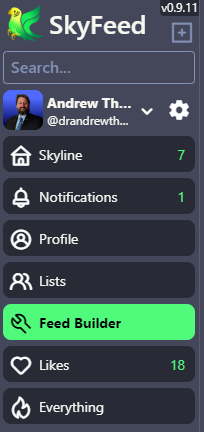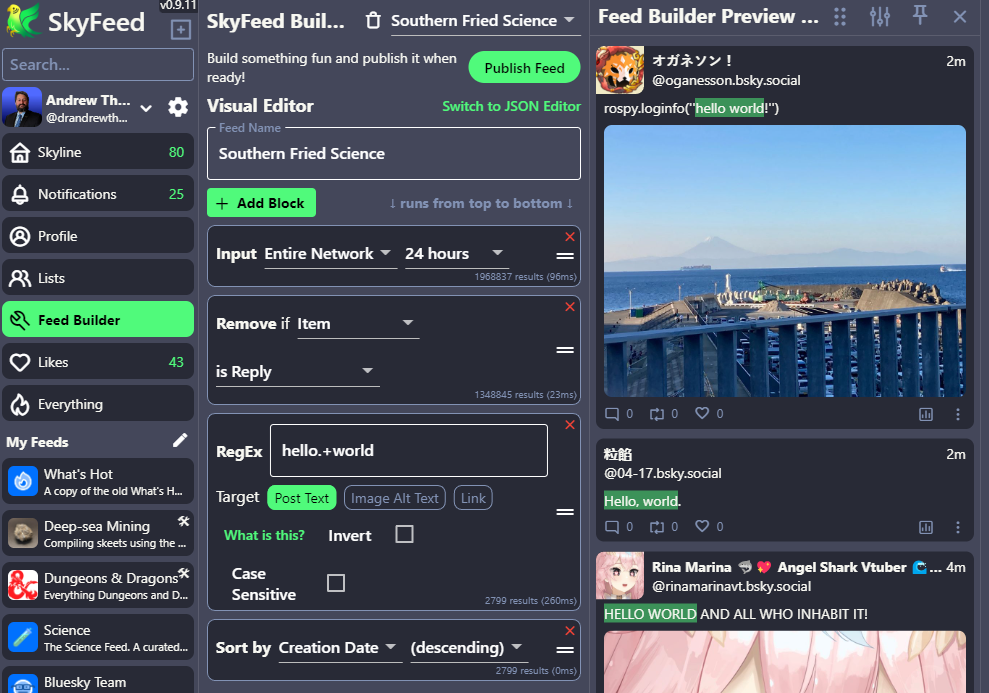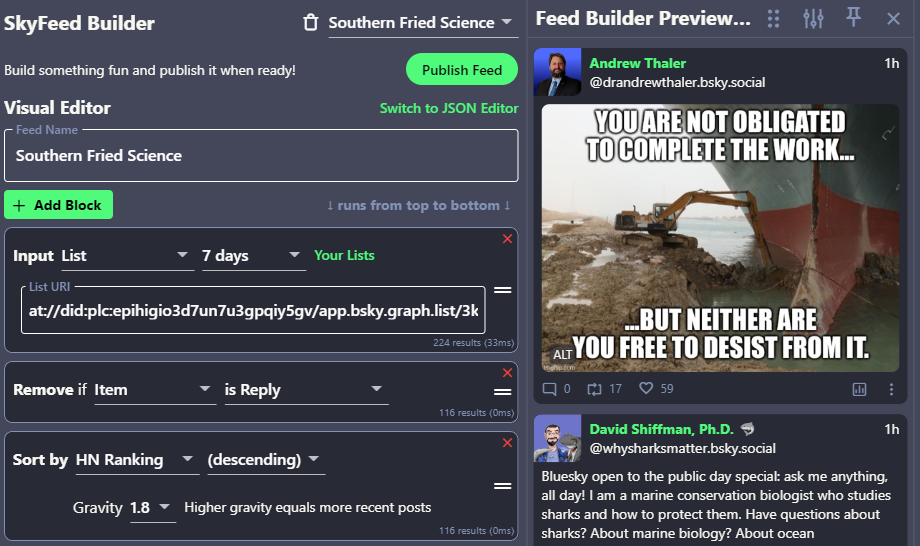So, you’ve made it! The remnants of science twitter have at last begun to coalesce around a new microblogging platformed owned by questionable individuals with inadequate content moderation that groans under the weight of a massive surge in new users. Welcome to Bluesky.
Honestly, it’s pretty great, in the way that Twitter circa 2012 was pretty great. While there’s a lot going on underneath, the whole site resembles early Twitter. It’s easy to get back into the groove.
Bluesky has one killer feature that I believe makes the entire value proposition of moving to a new network worth the effort: Custom Feeds.
On every other major social network, you are beholden to The Algorithm, a pile of math that determines who and what you see in your social media feed and dependent on the priorities of the site owner. Bluesky doesn’t have a The Algorithm, at least not yet. Post still roll in chronologically from the people you follow. At some point that will likely change as Bluesky figures out how to make money off of this endeavor, but for now, the timeline is an honest-to-cod timeline.
Instead of a singular The Algorithm, Bluesky has custom feeds, keyed to specific topics or interests. Here’s the neat part: Bluesky doesn’t make the feeds. We do. You can make your own The Algorithm on Bluesky, based on the type of content you want to see. And it’s really not all that hard to do.
When custom feeds launched, I created the Deep-sea Mining feed, which tracks mentions of keywords unique to the deep-sea mining industry. I also made the much more expansive Dungeons & Dragons feed, which captures conversations about the world’s most popular role playing game. By follow either of those feeds, not only do you get a dedicated tab for the topic, but they will also periodically show up in your main feed, if you allow them to.
I also created the feed Just Sharks Matter, which collates everything David Shiffman posts about sharks and the much less popular No Sharks Matter, which collates everything David Shiffman posts that isn’t about sharks. We have fun.
1. Go to Skyfeed
Skyfeed is a third party app that helps you manage and organize you Bluesky experience. Within Skyfeed is a custom Feed Builder.

2. Create a new feed.
In the upper right hand corner, there will be a dropdown menu with an option to create a new feed. If this is your first feed, it will default to a new feed. This will populate a bunch of options for how the feed will draw from Bluesky, include date ranges, types of posts, and who is posting. Many custom feeds, like Science, rely on a curated list of users to pull from, but other draw from the entire user base. If you’re using a list, you need to go back into Bluesky and create that list. The option to create a new list can be found on your profile, under the Lists item in the left sidebar.
Here I’ve created a custom feed for Southern Fried Science, but it currently pulls every post from every Bluesky user who posts “Hello world”. Let’s fix that.

3. Set you parameters.
I created a list called Southern Fried Science which includes all current and past Southern Fried Science writers with Bluesky accounts and then set the new feed to only pull from them. We don’t want everything everyone says, so we’ll exclude replies. With only 8 people on the list, sorting posts in chronological order is pretty boring. You could just follow them. So instead, we’re going to use the Hacker News ranking algorithm, a very basic ranking systems which helps surface the most popular posts while still keeping this generally chronological.

This is going to get very David and Andrew heavy very quickly, so let’s change a few things.
4. Learn some very basic Regular Expressions.
SkyFeed uses Regular Expressions to filter content within a Bluesky post. If you know RegEx, you can make some very sophisticated algorithms for screening posts, but you don’t need to get fancy. You can think of RegEx like old school Boolean operators with different symbology and SkyFeed will handle most of the heavy code lifting for you. Here’s a good cheat sheet. Your bread and butter is going to be the OR operator, which is just | (the heavy vertical line over your “enter” key on a qwerty keyboard).
We’re going to make a keyword list of things we don’t want to see in the feed, including mentions of “bluesky”, “followers”, and “twitter”, because navel gazing about the platform you’re on is boring, and then click the Invert checkbox to exclude those terms. In Skyfeed, that looks like this:

We might also want to include keywords. If we only wanted to see posts that point to Southern Fried Science, we could add a Block that looks for the word “southern” in links and then only returns those posts.
5. Publish the feed.
That’s it! You are now ready to publish your first custom feed. You’ll be prompted to describe the feed, pick an icon for it, and select a license for it (stick with the default if you don’t have any strong opinions). The feed we just made is right here: Southern Fried Science.
There’s a ton of other options you can explore to make that custom feed even more effective at surfacing the post that you want to see and share. This, more than any other feature, sets Bluesky apart from the mob of twitter copycats that emerged over the last year.
Southern Fried Science is free and ad-free. Southern Fried Science and the OpenCTD project are supported by funding from our Patreon Subscribers. If you value these resources, please consider contributing a few dollars to help keep the servers running and the coffee flowing. We have stickers.



Nice! I created a few feeds already and it’s pretty easy thanks to this tool!
Pretty cool, you cand actually combine 2 sources. This feed (https://bsky.app/profile/did:plc:v4zpi74gy7enfiwke7hmoxv5/feed/aaadsmq4vscnq) combines a Custom List of mine AND a search from the Entire Network for specific keywords.